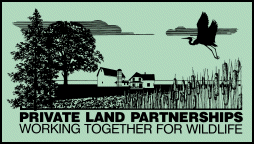 |
|
BIRD AND OTHER
WILDLIFE FEEDERS
|
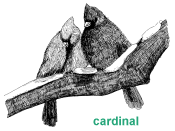 Wildlife
can not exist without the four components that comprise their habitat: food, water, shelter, and space. Your property may not be large
enough to provide all of the habitat
needs for the kind of wildlife you
wish to attract. However, you can offer one or more of these habitat components, even in a
small backyard environment. Providing a variety of feeding stations will give wildlife,
both residential and migratory, added incentive to visit your property. The more habitat
components you provide, the more wildlife species you will likely attract.
Wildlife feeders provide a supplement to the natural foods already available from nearby
trees, shrubs, and flowers. Therefore,
planting trees, shrubs, grasses, wildflowers, and groundcovers will increase the chances that wildlife
will frequent your yard. For example, a bird feeder that is next to a sheltering evergreen shrub will attract more
species than one that is not. This chapter explains how to provide feeding stations for
wildlife in your backyard. For information on providing cover for wildlife in your
backyard refer to the chapter on Homes for Wildlife,
and the other chapters in this section. Wildlife
can not exist without the four components that comprise their habitat: food, water, shelter, and space. Your property may not be large
enough to provide all of the habitat
needs for the kind of wildlife you
wish to attract. However, you can offer one or more of these habitat components, even in a
small backyard environment. Providing a variety of feeding stations will give wildlife,
both residential and migratory, added incentive to visit your property. The more habitat
components you provide, the more wildlife species you will likely attract.
Wildlife feeders provide a supplement to the natural foods already available from nearby
trees, shrubs, and flowers. Therefore,
planting trees, shrubs, grasses, wildflowers, and groundcovers will increase the chances that wildlife
will frequent your yard. For example, a bird feeder that is next to a sheltering evergreen shrub will attract more
species than one that is not. This chapter explains how to provide feeding stations for
wildlife in your backyard. For information on providing cover for wildlife in your
backyard refer to the chapter on Homes for Wildlife,
and the other chapters in this section.
Wildlife feeders can provide an opportunity to view wildlife from the comfort of your
home. The most popular types of wildlife feeders are those for backyard birds. Because
this is the most common type of wildlife feeding, there are a wide variety of feeders to
choose from. However, feeders can also be provided for other species such as pheasants, bobwhite quail, white-tailed deer, squirrels, chipmunks, rabbits, raccoons, butterflies, and moths. When
food supplies are scarce, such as in the very early spring or during bouts of severe
weather, wildlife will rely more on your feeders. Do not worry that the animals will
become dependent on your feeders. If you have to stop feeding for a month or so, they will
find alternate sources.
Backyard Birds
Location
The combination of habitat diversity
and the quality of available food are what will attract and keep songbirds at your
backyard feeders. Pick a location that can be seen from your house, where the seed hulls
and bird droppings
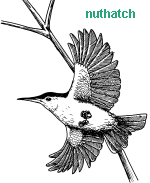 won't be a problem, and that you can easily access
year-round for filling and cleaning. If possible, locate the feeders near shelter such as
evergreen or deciduous shrubbery
that will provide protection from predators
and winter winds. Placing a discarded Christmas tree near the feeding stations may help
with this winter component. It is best to place hanging bird feeders on a metal pole
rather than on a tree limb, as this will help you to deter squirrel problems. Locating
feeding stations in several areas in the yard reduces crowding and lessens the chance for
avian diseases that can kill birds. Providing a water source in addition to feeders will
also help to attract birds to an area. Water that is dripping or splashing is especially
attractive to birds. There is no best time to start feeding birds. Once food is presented
and the birds find it, they will visit year-round. won't be a problem, and that you can easily access
year-round for filling and cleaning. If possible, locate the feeders near shelter such as
evergreen or deciduous shrubbery
that will provide protection from predators
and winter winds. Placing a discarded Christmas tree near the feeding stations may help
with this winter component. It is best to place hanging bird feeders on a metal pole
rather than on a tree limb, as this will help you to deter squirrel problems. Locating
feeding stations in several areas in the yard reduces crowding and lessens the chance for
avian diseases that can kill birds. Providing a water source in addition to feeders will
also help to attract birds to an area. Water that is dripping or splashing is especially
attractive to birds. There is no best time to start feeding birds. Once food is presented
and the birds find it, they will visit year-round.
Feeders and Food
Bird feeders are made of many different kinds of materials. They range from the simple
disposable bag feeders to elaborate steel, plastic, or glass feeders. Disposable feeders
are made of cloth, nylon, vinyl, and metal netting. These feeders are inexpensive, but
they do not protect the seed from the elements. Other more durable feeders are made of
materials such as plastic tubes; ceramic and terra cotta; woods such as redwood, cedar,
birch, pine, and plywood; metal sheets, glass tubes, and bottles. Most of these will keep
seed dry, but you should make sure that there are holes in the bottoms to ensure drainage.
If the feeders have trays, look for shallow trays that will catch the seed but not collect
water. Ultimately the feeder that you choose will depend on the types of birds you want to
attract.
You should begin by determining which species are likely to frequent your yard. This is
based on the type of habitat that surrounds your house. What you feed and how you present
it will determine what kinds of birds, and how many, will visit your feeders. You can
offer a variety of preferred foods based on what species you want to attract. Offering
commercially prepared mixed bird seed is not as effective as preparing foods customized to
the birds you want to attract. Most seeds in commercial mixes get thrown out of the feeder
as the birds search for their favorite seed. This favorite is the black oil sunflower
seed. It can be used in commercial feeders, tray or platform feeders, and tube feeders. It
is generally a safe choice as it is the favorite of most birds that visit these types of
feeders. The most effective way to attract the largest variety of birds is to provide
separate feeders for each food. Below is a description of the more specific types of
feeders and foods, along with the species that each would attract. |
|
Tube feeders are cylindrical tubes with several slots for feeding. When filled
with black oil sunflower seeds, the tube feeders will attract goldfinches,
chickadees, purple and house finches, woodpeckers, nut-hatches, titmice, redpolls, and
pine siskins. Adding a tray to this feeder will attract larger species that can not perch
on the small feeding holes, such as cardinals, jays, crossbills, mourning doves, and
white-throated and white-crowned sparrows. A tube feeder containing Niger thistle seed
with a tray will attract goldfinches, chickadees, redpolls, pine siskins, purple and house
finches, white-throated sparrows, song sparrows, and dark-eyed juncos. In addition, if the
tube feeder is an up-side-down feeder (has feeding holes below the perches), only
goldfinches will use it. When filled with peanuts, a tube feeder with a tray will
attract cardinals, chickadees, grackles, house finches, titmice, house sparrows,
starlings, mourning doves, white-throated sparrows, jays, and juncos.
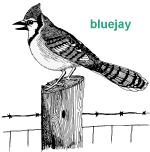 Tray or platform feeders are open feeders that can either be on the
ground or raised up on a stand, and have a lip around the edges to help hold seed on the
tray. This type of feeder provides easy access for many species of birds. When filled with
black oil sunflower seed it is a very general feeder and will attract most backyard
bird species. When filled with millet the platform feeder will attract doves, house
sparrows, blackbirds, juncos, cowbirds, towhees, chipping, field, and tree sparrows, and
white-throated and white-crowned sparrows. When filled with corn the platform
feeder may attract starlings, house sparrows, grackles, jays, juncos, doves,
white-throated sparrows, bobwhite quail, pheasants, and grouse. When filled with peanuts
the platform feeder will attract the same species as those attracted to a tube feeder
of peanuts mentioned above. Adding grit
to platform feeders will aid birds in digestion as they use it in their crop for grinding
food. Tray or platform feeders are open feeders that can either be on the
ground or raised up on a stand, and have a lip around the edges to help hold seed on the
tray. This type of feeder provides easy access for many species of birds. When filled with
black oil sunflower seed it is a very general feeder and will attract most backyard
bird species. When filled with millet the platform feeder will attract doves, house
sparrows, blackbirds, juncos, cowbirds, towhees, chipping, field, and tree sparrows, and
white-throated and white-crowned sparrows. When filled with corn the platform
feeder may attract starlings, house sparrows, grackles, jays, juncos, doves,
white-throated sparrows, bobwhite quail, pheasants, and grouse. When filled with peanuts
the platform feeder will attract the same species as those attracted to a tube feeder
of peanuts mentioned above. Adding grit
to platform feeders will aid birds in digestion as they use it in their crop for grinding
food.
Suet feeders contain suet
cakes that are made from animal fat generally derived from beef, pork, or deer. It can be
set out as just suet, or mixed with seed, dried fruit, or other foods. Suet is most
commonly used in the winter as it is a high energy food used in those times when food is
the most scarce. There are several ways of displaying suet. It can be placed in a simple
hanging bag such as an old onion or potato sack. Or, it can be placed in a feeder that is
rectangular and has a grid-like pattern across it for feeding access. This feeder can
either be laid out, or suspended. Suet feeders will attract chickadees, downy woodpeckers,
hairy woodpeckers, red-bellied woodpeckers, white- and red-breasted nuthatches, and
pileated woodpeckers. A hanging suet feeder will also attract wrens, kinglets, thrashers,
creepers, cardinals, and starlings. A feeder containing peanut butter suet will
attract woodpeckers, junkos, thrushes, kinglets, wrens, starlings, goldfinches, cardinals,
jays, and bluebirds. Suet feeders with
access only through the bottom will make it difficult for starlings to feed as they can
not hang up-side-down very well.
Nectar feeders are glass and plastic feeders that contain a sugar water solution
that can be made at home (four parts boiling water to one part sugar), or purchased
commercially. These feeders are most popularly used to attract hummingbirds. However,
other birds that have been known to feed on nectar include orioles, tanagers, cardinals,
finches, woodpeckers, and thrushes. These birds will not eat out of feeders made
specifically for hummingbirds, as they need larger perches. However, there are also
feeders made with these perches.
Many birds will feed on fruit, such as an orange half, if it is simply placed
out on a ledge or speared on a tree limb. Birds that are attracted to fruit are orioles,
tanagers, mockingbirds, thrashers, bluebirds, cardinals, woodpeckers, jays, starlings,
thrushes, cedar waxwings, and yellow-breasted chats. These birds may also eat grape jelly
if it is placed out on small trays. Feeding with fruit is usually done in the
summer.
Potential Problems
 After you have set up your feeders you may find that you have unwanted
guests. One such problem is that of other animals eating out of, and sometimes
monopolizing, the feeders. Squirrels are the biggest culprits when it comes to taking over
bird feeders, as they scare off birds when they are at the feeders, and often end up
destroying the feeder by gnawing right through it. The simplest solution to the squirrel
problem is to place the feeder on a pole away from houses and nearby tree limbs, and place
a baffle on the pole. A baffle is a
smooth metal sleeve or cone that prevents climbing. The most effective squirrel-proof
feeder is the pole-mounted metal house type with a perch that closes the feeder when
something as heavy as a squirrel sits on it. You may also want to place feeders
specifically for squirrels among your other feeders, as this will deter them from the bird
feeders. Other seed snatchers include chipmunks, rats, and mice. Reducing seed spillage
under the feeder by avoiding mixed bird seed will deter them. Also, storing your seed in
metal garbage cans will eliminate consumption of stored food. After you have set up your feeders you may find that you have unwanted
guests. One such problem is that of other animals eating out of, and sometimes
monopolizing, the feeders. Squirrels are the biggest culprits when it comes to taking over
bird feeders, as they scare off birds when they are at the feeders, and often end up
destroying the feeder by gnawing right through it. The simplest solution to the squirrel
problem is to place the feeder on a pole away from houses and nearby tree limbs, and place
a baffle on the pole. A baffle is a
smooth metal sleeve or cone that prevents climbing. The most effective squirrel-proof
feeder is the pole-mounted metal house type with a perch that closes the feeder when
something as heavy as a squirrel sits on it. You may also want to place feeders
specifically for squirrels among your other feeders, as this will deter them from the bird
feeders. Other seed snatchers include chipmunks, rats, and mice. Reducing seed spillage
under the feeder by avoiding mixed bird seed will deter them. Also, storing your seed in
metal garbage cans will eliminate consumption of stored food.
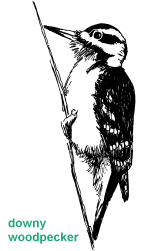 Another problem encountered at feeders is that of predators. Avoid placing
the feeders in an area that has a lot of ground cover as this provides good places for
mammalian predators to hide. Cats pose a serious threat to backyard birds, especially to
nestlings, fledglings, and roosting birds, as they are not natural predators. When a cat
is present in your yard you are not likely to see many birds at your feeders. If possible,
keep cats indoors, or use a belled collar to warn birds. Other predators that you may see
that do not present a problem are the Cooper's hawk and the sharp-shinned hawk. These
birds are natural predators and play an important part in the natural community. Do not be
concerned about the occasional kill these birds may make. Observing all birds in their
natural behaviors is one of the joys of feeding them. Another problem encountered at feeders is that of predators. Avoid placing
the feeders in an area that has a lot of ground cover as this provides good places for
mammalian predators to hide. Cats pose a serious threat to backyard birds, especially to
nestlings, fledglings, and roosting birds, as they are not natural predators. When a cat
is present in your yard you are not likely to see many birds at your feeders. If possible,
keep cats indoors, or use a belled collar to warn birds. Other predators that you may see
that do not present a problem are the Cooper's hawk and the sharp-shinned hawk. These
birds are natural predators and play an important part in the natural community. Do not be
concerned about the occasional kill these birds may make. Observing all birds in their
natural behaviors is one of the joys of feeding them.
A serious problem encountered at many feeders that can easily be avoided, is that of
avian diseases. When feeders are not properly maintained they become havens for bacteria.
Several precautions can be taken to ensure that the birds visiting your feeders remain
healthy. Avoid crowding the birds in a small space, as overcrowding facilitates the spread
of diseases. Keep the feeders clean of waste and food droppings. Feeders should be cleaned
once or twice a month with a mixture of warm soapy water and a capful or two of household
bleach. Clean more often during humid summer months and cool, wet weather to avoid food
spoilage.
Other Wildlife Feeders
Spike Corn Feeders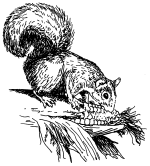
Many people view squirrels as a nuisance to their bird feeders. However, there are
those that enjoy their playful antics and would like to see more of them in their yards.
Squirrels can be fed by placing ears of corn on spikes that are fastened to trees or
platforms. If the ears are not attached, the squirrels will carry them away. Pheasants and
deer may also use this type of feeder, especially if you live near agricultural
land.
Log and Stump Feeders
A log or a large diameter branch laid horizontally, either on the ground or slightly
raised can be used as a feeding station for squirrels, chipmunks, raccoons, deer, and
various birds. One way to present food on this feeder is to create hollowed spots on the
top side of the log and fill them with seed, corn, peanuts, or suet. Other options include
placing spiked corn cobs or fruit on the top of the log. These methods can also be used in
the same way on the top of a tree stump. Drilled holes on the side of a dead tree that are
filed with suet may attract woodpeckers.
Butterfly and Moth Feeders
You will attract many butterflies and moths by planting wildflowers. However,
supplemental feeders will increase the likelihood that they will frequent your area.
Butterflies can be fed by simply placing a small plastic kitchen
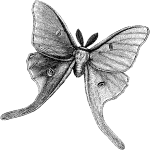 sponge
in a sugar solution in a shallow bowl. They will land on the sponge and lap the solution
through the holes just as they would from a flower. Moths are slightly more difficult to
feed. There are several "brews" that when painted on a tree at night will
attract moths. One such brew calls for mashed fermented peaches and sugar. Another such
brew calls for four pounds sugar, one bottle of stale beer, and some cheap rum. A third
recipe consists of fermented bananas, dried apricots, and brown sugar. Checking the trees
at night with a flashlight will allow you to spot the moths. sponge
in a sugar solution in a shallow bowl. They will land on the sponge and lap the solution
through the holes just as they would from a flower. Moths are slightly more difficult to
feed. There are several "brews" that when painted on a tree at night will
attract moths. One such brew calls for mashed fermented peaches and sugar. Another such
brew calls for four pounds sugar, one bottle of stale beer, and some cheap rum. A third
recipe consists of fermented bananas, dried apricots, and brown sugar. Checking the trees
at night with a flashlight will allow you to spot the moths.
In summary, the more habitat components you have available in your yard, the more
wildlife species you will attract. There are many ways that you can add the important
habitat component of food to your yard. To supplement the natural food components in your
area, you can add wildlife feeders to your yard. These feeders, if properly implemented
and maintained, will provide you with the opportunity to view wildlife and learn about
their natural behaviors.
For more information available on the World Wide Web about "Bird and Other
Wildlife Feeders," please see our Resource Links.
Last Revised: May 5, 2000
|

